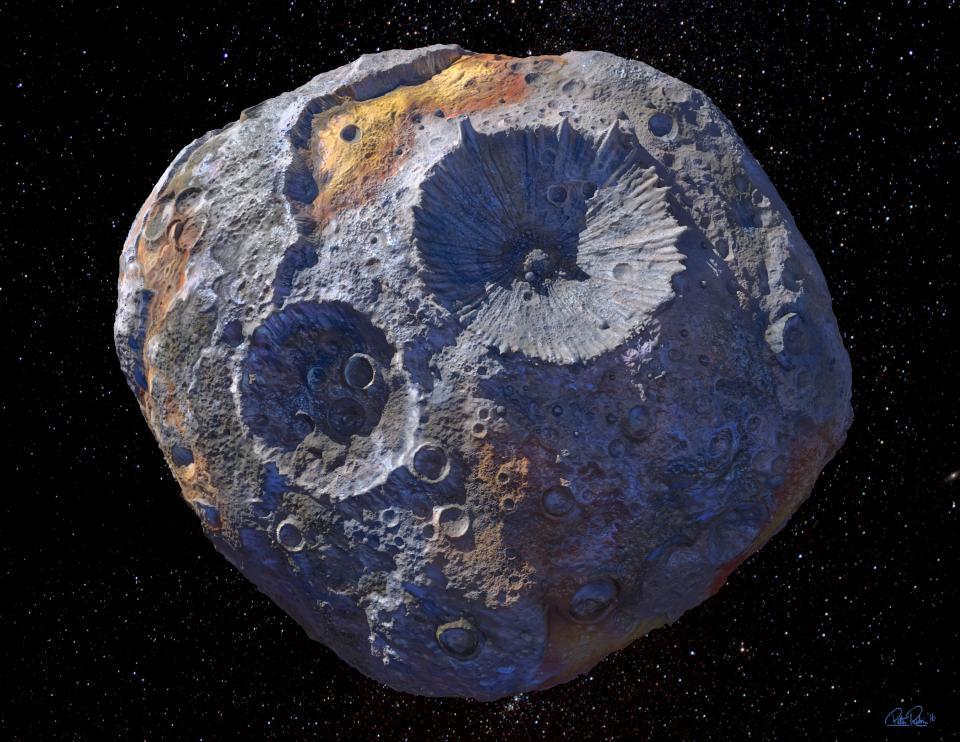This is one deity we wouldn’t want appearing on Earth.

The asteroid 16 Psyche, named for the ancient Greek goddess of the soul, is one of the most mysterious objects in our solar system. But in a few years humanity will be getting a close-up view thanks to a newly confirmed NASA mission.
Located in the large asteroid belt between Mars and Jupiter, Psyche may have started out as a planet that got bumped around so badly during the formation of the solar system that the outer layers of rock were blasted away, revealing a core similar to Earth’s.
What’s left is a chunk of metal made up almost entirely of iron, nickel and (presumably) a number of other rare metals like gold, platinum, copper, cobalt, iridium and rhenium. There’s nothing else like it in our galactic backyard.
“It’s such a strange object,” said Lindy Elkins-Tanton, the lead scientist on the NASA mission and the director of Arizona State University’s School of Earth and Space Exploration.
If the 200-kilometre-wide body could somehow be transported back to our planet, Elkins-Tanton has calculated that the iron alone would be worth US $10,000 quadrillion.
The gross world product (GWP) in 2015 was only about $73.7 trillion, so our economy would promptly collapse.
“That’s something I’ve contemplated for a long time,” said Elkins-Tanton of Psyche’s staggering value.
“Even if we could grab a big metal piece and drag it back here … what would you do? Could you kind of sit on it and hide it and control the global resource — kind of like diamonds are controlled corporately — and protect your market? What if you decided you were going to bring it back and you were just going to solve the metal resource problems of humankind for all time? This is wild speculation obviously.”
NASA isn’t planning to bring Psyche home, she noted, as the technology to do so doesn’t even exist.
Instead, the spacecraft that Elkins-Tanton and her team will launch by 2023 will be tasked with observing the asteroid and reporting back.
It will take until 2030 for it to reach Psyche, and the data it collects during its orbits should give scientists a better idea of how planets like Earth form and then separate into layers of core, mantle and crust.
WATCH: ISS crewmembers take part in spacewalk

The information collected may also produce an alternative origin story for Psyche.
“Short of it being the Death Star … one other possibility is that it’s material that formed very near the (sun) early in the solar system,” Elkins-Tanton said.
READ MORE: New astronauts and a solar eclipse will have Canadians looking skyward in 2017
The extreme heat from our burgeoning star would have melted the iron, she speculated, and Psyche could have survived in that primordial state right up until today.
“I figure we’re either going to go see something that’s really improbable and unique, or something that is completely astonishing.”
Adding to the excitement is new research that suggests the asteroid could contain water, which could make it a “resource stopover” as humans move further out into the galaxy.
“That water can be used to make rocket fuel or be drunk by people, so then we’d have a resource stop that has metal and water,” Elkins-Tanton noted.
Could Psyche supply an eventual colony on Mars? It’s too soon to say, but the two bodies are over 100 million kilometers apart so it could be tricky.
WATCH: Curiosity Rover discovers new evidence of life on Mars

Elkins-Tanton said that she hopes the Psyche mission, budgeted at US $450 million, will inspire people to look beyond our planet into the great unknown.
“I actually think that’s the purpose of space travel; to make us overlook the irritations of the everyday and the difficulties of politics and things like that, and look to a better future,” she said.
“I really wanted to inspire people to say, ‘I could take action, I could do something bigger.'”



Comments